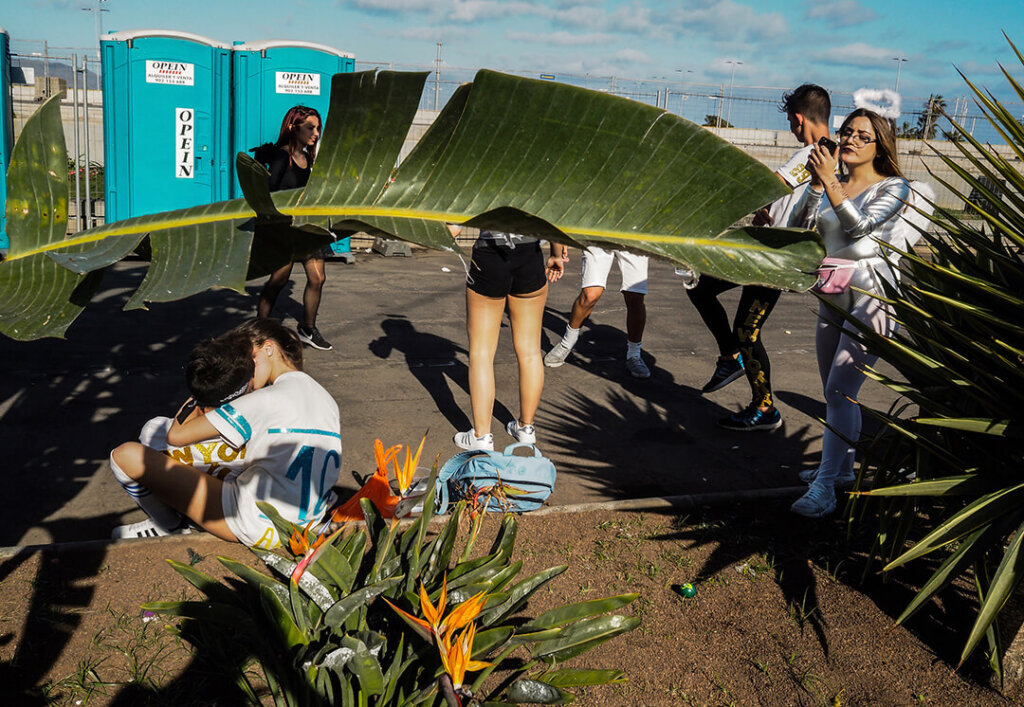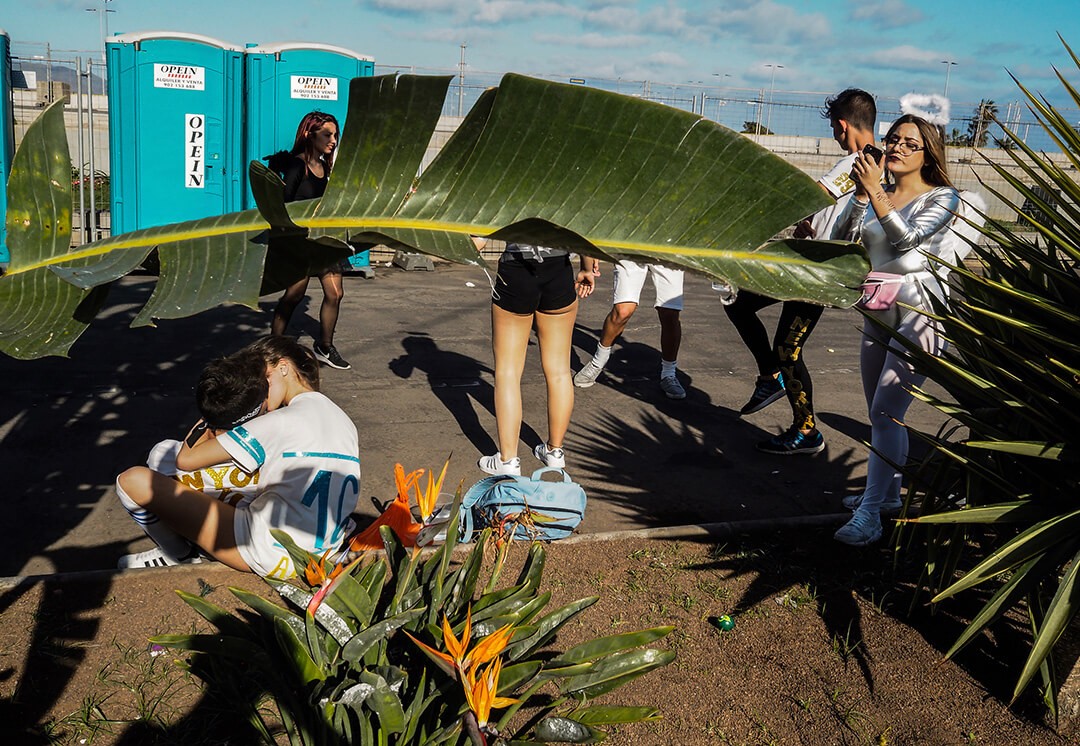
About Hakim Boulouiz
Hakim Boulouiz is a professional photographer currently living and working in Geneva, Switzerland. Most of Hakim’s street work is based on ordinary situations and daily events. “However, every ordinary moment can be transformed into an extraordinary one through the lens. The banal can become the most significant only if there is observation, patience, perseverance, composition and creativity.”
In February 2019 we interviewed Hakim to learn the making of story behind his award winning street photograph “Choral”.
Making Of Choral
Where and when did you make the photo, was it a familiar or new location to you?
My shooting took place in Santa Cruz of Tenerife, in February 2017, during the period of the “Brazilian” Carnivals that are hold in Spain. The crowd is large. Rhythm, color and fun are the watchwords. For many days, freedom and imagination take over the streets of this city in the Canary Islands – a real delight for a street photographer if he resists the never-ending, 24-hour sound-marathon!
Two parts build the Carnival of Tenerife: the official Carnival and the street Carnival. The first one presents mainly over a hundred real bands playing in the streets enjoying the participation of the local canary residents and the tourists taking the game by dressing up.
For my part, I found the second one most exciting, as it is more deconstructed, crazier, quite unexpected. I was not familiar with the Carnival of Tenerife, so my visit in 2017 was my first one. However, I have already attended other carnivals around the world, so I was comfortable and happy being in the crowd with my camera.
What was happening in the situation and what inspired you to start photographing it?
When I photograph events and ceremonies, I often realize that the best is found in the backstage of the scenery;the narrow streets rather than the main streets; the secondary spaces. There’s where I have more chances to come across things that are intriguing and more unusual as not everyone will see them and therefore there is an interest to immortalize them. For my shot it was like that how I came across this situation. Once at the spot, I have spent quite a lot of time composing my frame with the different components.
What were your thoughts and actions up until you finally pressed the shutter?
I waited for the ideal posture of each element in my frame, as simply an interesting scene is not enough. I watched out for magic – which is not an easy thing! Actually, this is the big difficulty of group photography. Each element that contributes is locked in it’s own occupation at this moment, as if it was alone in the world. It’s not simple to synchronize all of them so I kept observing, strolling my eye and my body from one place to another, from one story to another – not allowing myself to direct them because I’m taking photographs that are spontaneous and not in a spirit of studio photography. And most of all: I was determined not to leave the scene until I caught at least one valid shot.
Did the image come out as you imagined it to be?
Yes, it did absolutely and even better than what I’ve imagined! A little tip: I try not to look at my photos right after. I let them rest, marinate for a few days until I forget them a little bit. So, once I see them, I rediscover them with a different, cooler look and state of mind, as the emotions and influence of the shooting experience have already been and gone.
As a photographer, I fantasize about making photographs that you could spend hours looking at; that invite the observer to contemplate and to decode them. Like a gentle kiss, this concept is always accompanying me when I’m in the street hunting my photographic moments.
You named the image ‘Choral’, the term is closely related to music, could you elaborate on that?
Actually, for this image I quickly came up with the name, ‘Choral’, I’m saying “quickly” because sometimes it takes me days, even weeks, to be able to decide a name for of one of my photographs – finding the title is never an easy task. Nevertheless, I will never let an image or series go to the public without being named. For me this would be very irresponsible, even cruel, as it would feel to me as if I’d deprived a new born of its name.
Why ‘Choral’? In the occidental music, a choir designates a vocal ensemble, whose members, called choristers, sing collectively under the direction of a conductor such as a choir of a college, a parish or a village. So, what is a choral photography? Etymologically, it’s a style that is derived from the musical form of the chorus explained above. The word came to me from the concept of the choral film, where there’s no main character, but rather three or four that have relatively equal importance, e.g., American Graffiti (1973, George Lucas), Nashville (1975, Robert Altman) and 21 grammes (2003, Alejandro González Iñárritu).
By analogy, choral photography becomes a work that is distinguished by the transformation of several protagonists into several main subjects in one image. In other words; it is the anti-portrait, the opposition of the isolated, posited and the limitation. It is actually the photographic act by its composition, framing and staging that will bring together several stories in one same story – in one single initial frame that is pre-established by the photographer (as the leader and the guarantor of the choir).
Which post-processing work did you apply to the out of camera image, if any?
For all my street work the editing is very minimalist. I try to do the hard work during the shoot. So, I just optimize the contrast, saturations and sometimes the white balance for situations with difficult light.
What did you take away from making this picture?
In my mind as an urban photographer it’s in evidence that form and content are related. I advocate the perception of the streets I face, by the way I tell about them. So, for me the significance of my shots isn’t just about a nice form, but goes far beyond formalism.
A beautiful meeting like a dead-drunk sitting on the floor eating quinoa or a pink backpack carried by a grey dressed business man will never alone make a good photograph. A unique opportunity is just the starting point for a possible composition as the risk not to catch it is part of the game. This risk is actually the charm of this photographic discipline. The [art of] street photography rewards more than other forms a detached, humble and impartial state of mind of the photographer and his willingness to experiment. Letting the framework be a window to the world through which the beings and subject can enter, allows that each venture becomes an adventure and that the capture sparks existence. So, for me the challenge is to attend a meeting – real or surreal – that looms like treasure in the surrounding of the unexpected. This allows the shooting to become a moment of enthusiasm and magic. I believe that this is the real mission of the Street Photographer.
Links to Hakim Boulouiz
Website – http://www.hakimboulouiz.com
Instagram – http://instagram.com/hakim.boulouiz
Facebook – http://www.facebook.com/10207713399862370
Flickr – https://www.flickr.com/people/c47studio
Interviews with Hakim Boulouiz
2019, Masters of Photography – https://mastersof.photography/what-ive-learned-a-photographers-journey-hakim-boulouiz/
2017, Streetphotography.com – https://streetphotography.com/call-it-electricness-the-carefully-considered-street-photography-of-hakim-boulouiz/
2015, Gulf Photo Plus – https://gulfphotoplus.com/blog/910/Member-in-Focus-Hakim-Boulouiz
